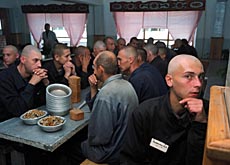
Images convey reality of Siberian prison camp life

Nothing can be regarded as black and white at an exhibition in Geneva of colour photographs showing everyday life in Siberian prison camps.
They leave the viewer with the impression that in general the inmates of the camps are humanely treated, and yet…
They raise questions about the humaneness of confining men and women – as well as youngsters of school age – in the often-hostile climatic conditions of the vast and remote Russian region.
Between 2002 and 2004, Belgian photographer Carl De Keyzer gained access to some of the camps on behalf of the agency he works for, Magnum Photos.
The result can now be seen at Geneva’s International Museum of the Red Cross and Red Crescent.
In terms of scale and conditions, the prison camps have improved considerably since the worst days of Stalin’s gulags, when some 12 million people were detained in them.
But within the sometimes crumbling prison buildings still in use, malnutrition, disease and violence among inmates have not completely disappeared.
During his assignment, De Keyzer visited 35 of the approximately 130 camps around Krasnoyarsk in Siberia – a region as big as Europe where winter temperatures can fall to minus 65 degrees Celsius.
Camp categories
The penal institutions fell into three categories: factory camps usually located in towns where the work ranges from heavy industry to handicrafts; the more remote village camps where some detainees can be joined by their families; and – toughest of all – forest camps often hundreds of kilometres from the nearest town.
De Keyzer told swissinfo that permission to visit some of these camps came about by a combination of luck and persistence over a period of several months: “To begin with the visits were to ‘model camps’ usually shown to such visiting guests as foreign diplomats and journalists.
“In fact the first camp I saw was a kind of Disneyland, its gates decorated with model soldiers made by prisoners, and with huge murals. There was even a wooden windmill and an Egyptian-style pyramid… just like you would see at the entrance of any cheap amusement park.”
He made that visit while running a photography workshop to coincide with an exhibition on the former Soviet Union.
Persistence
It whetted his appetite. Official reluctance to grant access to more camps – many were “off limits” to foreign journalists – was finally worn down by De Keyzer’s sheer persistence.
Several months later, the general in charge of regional prison facilities granted him permission to visit other camps.
In them, De Keyzer came across people who had been detained for petty theft or not paying taxes, as well as for serious crimes. Some camps had libraries, sports fields and even a discotheque, and inmates didn’t always have to wear a uniform or shave their heads.
Food tended to be “old fish” and bread.
These days the camps no longer house political prisoners, and detainees tend to come from the surrounding region rather than such cities as Moscow and St Petersburg.
Of course, De Keyzer was “accompanied” on his travels and he does not hide the fact that in some cases the reality was “touched up”.
Bizarre tennis game
One bizarre example of this came when he saw a tennis court in one of the camps and was told it was for the detainees.
“They looked for two prisoners to play a game and eventually found rackets. I asked them where the balls were but they couldn’t find any.
“So we had this ridiculous scene with me photographing two prisoners pretending to play tennis without a tennis ball. It was like a crazy mime scene.”
De Keyzer chose to record what he saw in colour rather than black and white because he felt that the latter belonged to the past, while colour represented the “now” and added to what he describes as “the dreamlike atmosphere” of the camps.
He freely acknowledges the attempts made by the military to use him for propaganda purposes: “I saw no evidence of torture or dead bodies and so on.
“So I played their game and exaggerated their attempts to show me the bright side of the camps. This may not look real but it enables the viewer to read between the lines, and think hard about what he or she is seeing in each photograph.”
The exhibition is at the International Museum of the Red Cross and Red Crescent in Geneva until July 18.
swissinfo, Richard Dawson in Geneva
The exhibition is at Geneva’s International Museum of the Red Cross and Red Crescent until July 18.
Belgian photographer Carl De Keyzer gained access to 35 of the approximately 130 Siberian prison camps around Krasnoyarsk.
The camps are in three categories – factory, village and forest camps.
De Keyzer says the prisoners – including youths – are no longer detained for political reasons but many are there for committing petty crimes.
The situation has improved considerably since the worst days of Stalin’s gulags, when some 12 million people were detained.

In compliance with the JTI standards
More: SWI swissinfo.ch certified by the Journalism Trust Initiative





























You can find an overview of ongoing debates with our journalists here . Please join us!
If you want to start a conversation about a topic raised in this article or want to report factual errors, email us at english@swissinfo.ch.